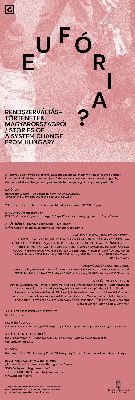
Eufória? / Euphoria?
Rendszerváltás-történetek Magyarországról / Stories of a System Change from HungaryCapa Központ, 2019
kritika - ÉS
kritika - Artmagazin online
kritika - Kultúra.hu
Scroll down for English text
A Kádár korszak hiánygazdasága különös kép-pótlékokat is életre hívott. A szocializmus évtizedeiben nem árultak semmiféle férfimagazint, soft- vagy hard-pornólapot, azonban a nyugatra kijutott szerencsések néha hazahoztak magukkal ilyesmit, poggyászukba rejtve olykor mégis bekerültek az országba.
Apám is a szerencsések közé tartozott, munkaköréből kifolyólag rendszeresen járt nyugaton, és időnként ő is hozott magával pornólapokat. Ezeket nem csak azért rejtette el otthon, mert még kicsik voltunk, és nem volt nekünk való az ilyesmi, hanem azért is, mert tiltott sajtótermékek voltak, amiket az ember nem tett ki a kirakatba. Jól emlékszem a lapokra, mert amikor a rendszeres otthoni házkutatásaim során mégis rájuk bukkantam, titokban nézegettem őket, és ez a teher súlyosan nehezedett rám. Egyszer, 8-9 éves koromban le is buktam. A helyzet visszássága miatt büntetés helyett apám inkább egy faramuci érveléssel próbált eltántorítani a további kutatásoktól, miszerint, ha meztelen nőt akarok látni, elég magamat nézegetnem a tükörben.
Apám gondosan elzárta gyűjteményét, mások azonban ezeket a lapokat jellegzetesen amatőr, kisipari módon sokszorosították, így kerültek be a másodlagos nyilvánosság körforgalmába. Az egyes oldalakat lefotózták, házi laborokban kisméretű nagyításokat készítettek róluk, majd a reprodukált képeket leporellószerűen összeragasztották. A cigarettásdoboz méretűre laborált képek elfértek a farzsebben vagy a tárcában. Terjesztésük, akárcsak az 1900-as évek első évtizedeinek pornográf fotóié, informális úton, személyes csatornákon történt.
Ugyanennek a reprodukáló eljárásnak volt egy legális változata is. A szocialista Magyarországon ugyanis könnyűzenei magazinok sem léteztek, a Bravo és társai a szex- és pornólapokhoz hasonló módokon lépték át a határt. Ezek oldalairól is kártyanaptár méretű fekete-fehér fotókat készítettek, kisipari eszközökkel, de nagyipari mennyiségben, mert az együttesek és énekesek (no meg a filmsztárok) fotóit legálisan árulták a trafikokban. Innen származik a házilag sokszorosított termékek elnevezése, a “trafikkép”.
A tárlóba két legálisan árusított, házilagos eszközökkel, fotográfiai montázs útján készített kártyanaptár; valamint három 1970 körül kiadott nyugati pornográf lap korabeli, fotózással reprodukált és sokszorosított, informális úton terjesztett „trafikkép”-változata került.
The shortage economy of the Kádár era gave rise to strange supplements also in terms of images. In the decades of socialism, no erotic or pornographic men's magazines were sold legally, but the lucky ones who made it to the West brought some of these to home from time to time. My dad was also one of them – he had regular business trips to the West, and sometimes brought home erotic magazines. He hid them in the house not only because we were too young to see those kinds of things, but also because these were forbidden press products that you did not want to put on show. I remember clearly these mags because, despite dad's precautions, I came across them during my notorious home search sessions, I peeped through them in secret, and this put a heavy emotional burden on me. Once, when I was 8 or 9, I got busted but, because of the awkwardness of the situation, instead of punishing me, dad tried to dissuade me from further snooping with the argument that if I wanted to see a naked woman, it should be enough to look in the mirror. Of course, I did not abandon the home search. Years later, I found some porn mags beside the erotic ones.
My father carefully locked away his collection from prying eyes, but others straight out made reproductions of them, typically in a DIY artisanal manner, and that is how these pictures entered and then circulated in the secondary market. The pages were photographed individually, and then scaled down in at-home labs, and eventually glued one after the other in a folded leaflet-like fashion. The images, reduced to the size of a cigarette box, fit in a back pocket or a wallet. Their distribution, just like that of the pornographic photos back in the first decades of the 1900s, took place informally, through personal channels.
However, there was a lawful segment within the market of the merchandise made by this process – pop music magazines were also banned in socialist Hungary; Bravo and the like crossed the moral line in the same way as porn. Their pages were also made into card-size black and white photos with small-scale tools, but in large quantities, as it was a licit business activity to sell photos of bands and singers (and, of course, movie stars) in kiosks. Hence their name became ’kiosk pictures.’
The display case contains two homemade calendar cards with photo-montage kiosk pictures that were legally trafficked back in the day, as well as three reproductions of western pornographic magazines made with photographic techniques and informally distributed around 1970.